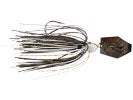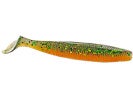Crediting the Jack Hammer Chatterbait for multiple victories across tournament trails, Bassmaster Elite Series pro Brett Hite calls the bladed swim jig his favorite technique. One can hardly argue when it has been said the lure was responsible for nearly a half million in winnings throughout Hite’s fishing career. The versatility of the bait, the vibration and the erratic hunting action that the lure provides can consistently entice bigger fish,” explained Hite. “The hunting action is similar to a squarebill crankbait, but even greater. The quality of fish that that action can attract is truly noticeable.”
Pre Spawn Chatter:
One of the reasons that Hite feels the lure can be so successful in the spring is its vibration. He launches the lure into action in the early spring, when the pre spawn phase kicks off. “I will throw it when water hits the mid to high ’50s,” said Hite. “I usually throw a 3/8, but I may go for a 1/2 oz in pre spawn, because the grass isn’t as tall and I want to get down a little deeper to maintain contact with the cover.”
Hite doesn’t view the Chatterbait as just a “grass-style bait”. He puts it into action any place that one would employ a  spinnerbait. He touts its versatility and uses it in all types of scenarios from clear to dirty water, around brush or wood, riprap or rock piles. “In pre spawn, I am looking for any type of cover to work around,” explained Hite. “It is like a crankbait, I want to have the lure make contact with whatever cover that I’m fishing.”
spinnerbait. He touts its versatility and uses it in all types of scenarios from clear to dirty water, around brush or wood, riprap or rock piles. “In pre spawn, I am looking for any type of cover to work around,” explained Hite. “It is like a crankbait, I want to have the lure make contact with whatever cover that I’m fishing.”
He explained the main difference in throwing a Chatterbait in the pre spawn is the slower retrieve. “Of course, I would want to speed it up here and there to give it some erratic action, but overall, pre spa wn is a time when fishing is just a little slower. Another thing to consider with retrieve speed is that the vegetation in grassy fisheries hasn’t topped out real high during pre spawn, so you have to slow down and move lower through the water column, to allow the lure to make contact with the grass.” When fishing pre spawn targets, Hite locates areas where the fish are going to be moving for the next stage of the spawn. “I am looking for transition areas, like secondary points going into the spawning areas where the fish like to set up,” he said.” Hite often fishes the lure using a Yamamoto Swim Senko or the new Yamamoto Heart Tail as the trailer. He doesn’t change the type of trailer through the stages, but will upsize during pre spawn and downsize through the later stages.
wn is a time when fishing is just a little slower. Another thing to consider with retrieve speed is that the vegetation in grassy fisheries hasn’t topped out real high during pre spawn, so you have to slow down and move lower through the water column, to allow the lure to make contact with the grass.” When fishing pre spawn targets, Hite locates areas where the fish are going to be moving for the next stage of the spawn. “I am looking for transition areas, like secondary points going into the spawning areas where the fish like to set up,” he said.” Hite often fishes the lure using a Yamamoto Swim Senko or the new Yamamoto Heart Tail as the trailer. He doesn’t change the type of trailer through the stages, but will upsize during pre spawn and downsize through the later stages.
“Sometimes, I will go with a Yamamoto Fat Craw, if I am trying to mimic more of a crawdad appearance,” he said. “My trailer colors for pre spawn are a green pumpkin color or a reddish color to mimic the bluegill or a crawdad.”
Spawn Adjustments:
As the season progresses from pre spawn to spawn, Hite adjusts target areas for the Chatterbait. “I am going to target little pockets,” he explained. “I am not visually fishing beds with it, but winding over areas that beds are around. I am fishing places like a pocket beside a tree, holes in the tules or a little corner that you can tell a fish would like to spawn. If I visually spot a bunch of cruisers that aren’t really on beds, I will blind cast and wind the Chatterbait around in that area.” As the water temperature rises from the cooler pre spawn temps, the fish become more active and the speed of the retrieve can increase. “It is textbook reaction bait fishing,” he said. “The warmer the water, the more active the fish are. The more active the fish are, the faster I am going to be able to retrieve the it.” Another adjustment that Hite makes for the spawn, is a color change. “Obviously, the fish are going to be on beds and this is when I might go to a brighter color,” he elaborated. “I still like green pumpkin, but most likely, I am going to get away from the red color and go to a color that imitates a baitfish or a bluegill with some chartreuse in it.”
Post Spawn Changes:
Hite likes to target post spawners first thing in the morning. “The shad spawns tend to happen bright and early in the day, so this time of year it is always best to get out there at day break, right at first light, to look for the shad spawn and the bass that are also looking for the shad.” His color selection changes again as he targets post spawn fish. “The shad and baitfish spawn a little later than the bass,” noted Hite. “The shad spawn is going to be a big influence on the color choice. Because of the influence of the shad, most of the time in post spawn conditions, I am going to use a shad color, either a white or crystal shad. I will switch it up to a silver blade to really mimic a baitfish, because bass really key in on baitfish at this time of year.”
Chatterbait Gear:
Hite feels the technique’s success is reliant on the rod and reel setup. “I use a 7’3″ medium-heavy EverGreen Bret Hite casting rod,” he said. “A fiberglass or composite rod is the number one key.” He believes one of the biggest misconceptions about the Chatterbait is that anglers see it as a jig and so they don’t use the correct rod. “To avoid losing fish with this technique, I think of it as a heavier crankbait or spinnerbait and use a fiberglass rod. Fish will hit the Chatterbait aggressively, so I want the rod to load up and absorb some of that hit. A lot of times the fish will hit right at the boat, and if you have a really stiff rod, when that happens, you will get slack in your line and lose the fish. This is why you want a glass rod. The rod and the line is the key to being successful at landing fish.” Hite suggests a mid-speed reel, in the 6.5 to 6.2:1 range. His reel is a Shimano Chronarch casting reel. “You want a medium range, so that you can slow roll or go pretty quick when you need to,” he stated. “I always use 20 lb FC Sniper fluorocarbon. I never use braid or mono. Fluoro is less visible in clear water situations and I like the little bit of stretch that it has. I don’t ever break off any fish and I’ve caught tons and tons of giant bass, so I feel it is best.”
Click Link To Shop: Bass Angler Magazine

